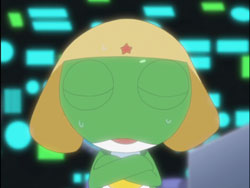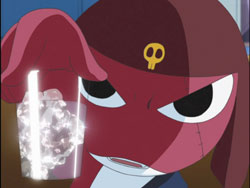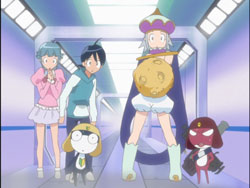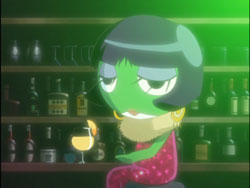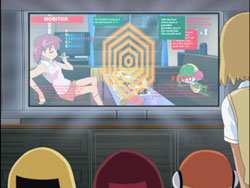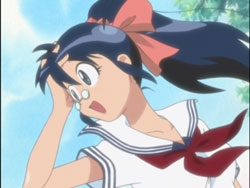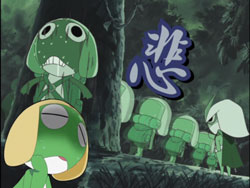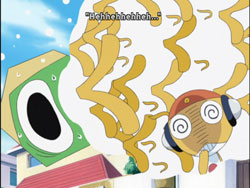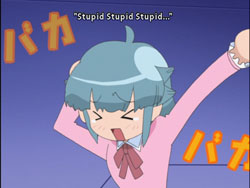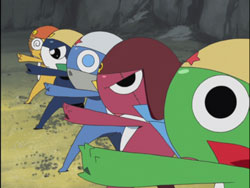 Logo handmade by Bannister
Column by Scott Green
Logo handmade by Bannister
Column by Scott Green
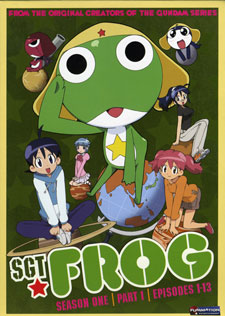
Anime Spotlight: Sgt. Frog Season 1, Part 1 Released by FUNimation
Years ago, at an anime convention panel, someone asked ADV rep David Williams if his company planned to license Sgt Frog. That sort of question is always being asked of anime company reps, and the canned response in almost every case is a non-committal "can't confirm of deny interest." Apparently, Williams didn't think the Sgt Frog query was particularly bright, because the answer was roughly along the lines of "you mean, the series with all the references to Bandai's Gundam franchise?" What an arduous trip it's been from there to here. Sgt Frog, aka Keroro Gunso began as a manga by Mine Yoshizaki, a doujinshi artist and assistant to Katsu Aki (Manga Sutra) whose professional oeuvre is highlighted by pastel, cherubic cute girls with risqué elements to the design - his reimagining of Osamu Tezuka's Marvelous Melmo and Evangelion's angels to point out a few. In his story, a squad of two foot tall imperialist frog alien foot soldiers arrive on Earth, referred to by them as Pekopon (more on this later), with designs on taking over the planet. First problem: the team finds themselves split up and disorganized on arrival. Second problem: they go native. The eponymous leader Sergeant Keroro lands in the Hinata household where he moves in with Fuyuki, an oblivious but enthusiastic schoolboy with a blazing interest in the odd and occult, his fiery tempered, athletic older sister Natsumi, and their frequently absent workaholic/manga editor mother, Aki. So, between being fawned over by Fuyuki and berated by Natsumi, Keroro begins a life of doing house hold chores in order to fund his new passion - assembling plastic Gundam models. His, adoring junior, Private Second Class Tamama finds a home with Momoka Nishizawa, a demure but secretly raging and crushing hard classmate of Fuyuki, where Tamama is exposed to luxuries and junk food. Bellicose veteran Corporal Giroro barks at Keroro, but also finds himself smitten with Earth's cats and curry. And, so on for the rest of the group.The manga ran in Shonen Ace, an anthology known for its many anime tie-ins, such as the Neon Genesis Evangelion manga. As the name applies, it's for a shonen audience, but it skews older than periodicals like Shonen Jump or Shonen Sunday, as it features darkly disturbing, and/or violent works, populated by older characters such as Goth, MPD Psycho, Welcome to the NHK, Kerberos Panzer Cop and Kurosagai Corpse Delivery Service With its spotlight on Keroro and Fuyuki, the Sgt. Frog manga was staged to appeal to a geek audience, with characters who were salivating fans of genre media referencing to and indulging in that passion, but also reproducing items from popular works such as Gundam, Battleship Yamato and Mazinger - for example , Giroro is armed with micro versions of weapons used by Gundam's titular giant robot. Then, there's is Yoshizaki's penchant for trotting out the cute/sexy bishojo - not just having Natsumi tied in various frog organized, half baked plots, but scenes like daffy kogal/Lord of Terror secret cosmic world destroyer Angol Moa getting drunk at New Years and taking off her top before passing out, half naked. Given Sgt Frog's many Gundam references/promotion plugs, it is not surprising that the animated adaptation landed at the franchise's home, Sunrise - a studio known for mecha anime and works longer than the de facto standard 13/26 episode package, such as Code Geass, Big O, the Brave Series (GaiGaiGar), InuYasha, and Ronin Warriors - also with other notable anime that does not fit that description, such as Cowboy Bebop. With Junichi Sato, a veteran known for magical girl and children's works, (Sailor Moon, Magical DoReMi, Princess Tutu, Maple Town) the series has been a success for Sunrise as it approaches its 300th episode. While the anime kept most of its geek humor and some of its titillating notes, it aimed at an audience younger than Shonen Ace's, with a time slot joining the likes of One Piece (weekdays 5pm to 8pm, moved to Saturday morning along with other series when anime's rating began dropping). And, globally the series has been packaged as a children's show, airing on cartoon networks and cartoon blocks from Malaysia to Israel to Norway. Back in 2006, when the anime was only 130 episodes in, a North American anime distributor announced that they'd picked up the broadcast, home video and merchandising rights to the franchise, and unexpectedly, it was ADV Films. ADV's website was reskinned with a "hacked by the frog" motif. A pilot trailer eventually made it online. DVDs were solicited, then held off as they tried to land a broadcast deal. Likewise, indications suggested ADV opted not to place the anime on their on television video on demand service while they pursued broadcast partners, also mentioning how the anime's injokes could be deemphasized to bolster the appeal to a a general audience. Sgt Frog was brought into the company as part of a "new era for ADV," ushered in by their partnership with Sojitz. Unfortunately by January 2008, the Sojitz deal fell apart - a fracture that presumably played a significant part in the subsequent restructuring and asset sales that ultimately lead to the end of the ADV name. Then in July 2008, FUNimation announced that they'd picked up over 30 titles in a deal with Sojitz, including Frog. Again, the evident goal was to find a way to situate Sgt Frog into a prominent TV outlet. Again, evidentially, various English dub approaches were attempted. Again, a dub pilot was posted online. FINALLY, Sgt Frog has made it out on DVD. Having read bits of the manga beforehand, I wasn't terribly enthusiastic to see the anime, but, it won me over. The injoke humor worked, even if it isn't a comedy style for which I have tremendous amounts of respect. The character dynamics worked well enough to push through any resistance and sell me on the series. Sgt. Frog has a few problems. It's irreverence isn't smart. The finale of this set of episodes features the introduction of a childhood friend of Keroro who the Sgt viciously tormented... pressuring him into body shattering stunts, breaking precious possessions and the like. Keroro is vaguely aware that what he did was poor form, but he doesn't feel terribly bad about it. The attitude of Sgt. Frog itself isn't very different. The frog alien invasion evokes World War II imperialism, with Keroro wearing a starred yellow hat like those worn by soldiers of the period, and the word Pekopon resembling Pokopen, a derogatory term used for Chinese people. The consensus in regions where these points became contentious was that objections were overplayed. Yet, while these elements are handled in a de-fanged manner, the approach is off-handed rather than subversive. Other potentially offensive elements have a greater potential to resonate among North Americans. Keroro's smirking references to being beaten as a child are at least infrequent. Unfortunately, the black face gag is a reoccurring one. Every so often, a bomb will explode in front of Keroro, where upon he develops an afro and a soul patch to go along with the soot covering his face. These aren't so much offensive as they are annoying. Given what the series seems prepared to handle, the jokes would have been better served by not over reaching with their implications. Sgt Frog never manages to hone its irreverence into a sharp edge, but the gears of its comedy mechanisms do click after a few episodes. It's a bit iffy in the early going. Episodes are split into segments of about 12 minutes, and initially the manga adaptations still fit loosely over the time frame. Early episode slot material that skew young into this space. The starkest example is an episode in which Keroro ventures to the local toy store to spend his allowance on a rare Gundam model. With the Hinata family's warning that if he were to be discovered, he'd be unceremoniously captured and dissected, obtaining the toy becomes a precarious operation, involving invisibility, hiding store merchandise behind other store merchandise and "Pekopon suits." The pseudo-desperateness only increases when Keroro discovers the old man running the store is about to close shop. The manga moves through the situation comedy quickly, with a predictable if understandable reason for the shop owner’s retirement, along the lines of comfortably moving in with his adult son's family. The anime inflates the story with sentimentality, staging a bittersweet of a story of quant shop going under in changing times. While Junichi Sato's brand of work frequently can shift into that tone, Sgt. Frog is unprepared for sedate niceness and as such, episodes that pursue that direction suffer from it. As Sgt Frog builds out its cast it manages to transcend mediocrity. First, there's comedy disfunctionalness of Keroro's team. Comparing them to Where the Wild Things Are is certainly overstating the case, but having recently seen the movie, the relationship between the frogs calls Wild Things to mind. Occasional exuberance breaks out of the gravitational pull of a broken group dynamic. Keroro's an inattentive leader. Tamama is possessive, passive aggressive and bipolar. Giroro is a rage-aholic. Group Sergeant Major Kururu, is a tittering, instigating jerk. It's the mechanics of comedy rather than anything of psychological depths, but the end results are a perpetual motion machine of personalities tuned to making life difficult for each other, That relationship between the characters provides a combustible basis for the anime's comedy formula, into which various sight and situation gags are mixed in. Sato, along writers like Mamiko Ikeda (Emma, I'm Gonna Be an Angel), Hiroshi Yamaguchi (Bastard!!, Desert Punk, Gatekeepers, Gurren Lagann), Satoru Nishizono (Digimon, Duel Masters, Hell Girl, Mazinkaiser, Welcome to the NHK) and Yasuko Kobayashi (Galaxy Angel, Witchblade) aren't complacent about what they pour into that formula. Geek humor in anime, staged as parody often starts with recognition gags - taking trappings known from another work and changing the context or usage - for example, dressing up the Hinatas as Guntank and Guncannon to shrink down and fight sentient cavity bacteria in Keroro's mouth. It isn't the wittiest mode of comedy, and the typical embellishment is to speed up the exchange of these references. Sgt Frog is helped by the gags' semi-organic growth from its unashamedly geeky characters. Yet despite these allegiances, Sgt Frog neither oversells nor over relies on its reference humor. A favorite instance of this is when the frogs' snake alien rival Viper, turns up with a red jump suit and gun arm a la Space Adventure Cobra and engages the frogs in a tokusatsu (think Power Rangers) style rock quarry battle. The frog team start their super attack, prepared with a few character moments of Kururu snickering and Giroro mean mugging the foe. From a showy acrobatics display, the attack moves from frog to frog in announced stages "Energy Ball charge" to "Double dribble violation" to "Travelling violation" to "Hole in one" to a free throw-like toss and delayed, cheesy special effects explosion. As in this case, the anime does launch its gags from a platform of familiarity with the referenced subjects, but the jokes are colorfully and joyfully ridiculous in their own right.
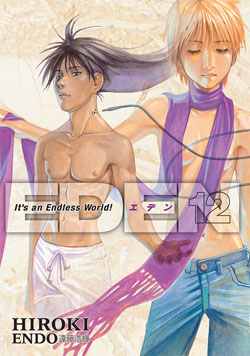
Manga Spotlight: Eden: It's an Endless World Volume 12 By Hiroki Endo Released by Dark Horse Manga
With the title resting high on my list of recommended manga, I've been impressed by Eden throughout. As such, I don't feel that there has been sufficient down time to warrant volume twelve being called a reward for patience. That said, the breathtaking sci-fi action manga has definitely begun to bundle elements together and pour some accelerant on the blaze. The manga commenced with an adolescent boy, an adolescent girl and a dying scientist on an isolated island known as Eden. As a pandemic of Closure Virus sweeps the globe, leaving behind calcified husks, this privileged few discuss metaphysics. Then a helicopter arrives, returning them to the world from which they had been protected... The better part of a generation passes, and the manga shifts its view to Elijah Ballard, the son of that boy and girl. With drug cartels operating as a front in the war between the new super-national UN replacement The Propater Federation and unified resistance groups, the manga's post-prologue early goings projects the brutality of war onto a local, personal scope. As Elijah tags along with anti-Propater mercenaries of Nomad, sci-fi elements like androids and bio-engineered soldiers are woven in with more current concerns such as landmines, hostage taking, conscription and ethnic cleansing. After shifting focus to cover some of Elijah's comrades in arms, when the manga returns, it rearranges its framework from sci-fi military/asymmetric warfare to straight urban crime saga. In that coming of age in a landscape of prostitutes and drug dealers, the manga drifted so far from the original island Eden that it bewildered some of its readers. It then transformed again, returning to geo-politics, such as the Chinese Uyghur conflict, and to the Closure Virus. 12 volumes in, Eden is synthesizing all of this in earnest... the virus, the sci-fi elements, the crime, the global politics, the motivations behind the Ballard family's actions... Beyond all of those disparate pieces, it was never apparent whether Eden's overtures towards Gnosticism were going to develop into anything substantial. Now they are... A pair of semi-divine artificial intelligences walk the earth. The female Letheia, with a Ghost in the Shell like construction of human brain in cyborg body accompanies Elijah. Maya, a consciousness in a male, human body, accompanies Elijah's sister Mana... occasionally visiting her mind in the guise of a serpent. So, a virus is releasing humans from their physical shells, turning cities into unified, hardened masses. At the same time, Maya and Letheia manifest themselves as possibly divinely inspired technologies. During a meeting between Maya and a team of scientists and military representatives, one of the soldiers matter of factly states that he'd kill Maya if it would stop the virus. Maya responds by smiling and mentioning that he'd just find a new body into which he'd implant his consciousness. When Maya leaves, one of the scientists remarks "Christ was murdered by human hands... but maybe god's learned a thing or two now..." A significant part of this coalescence is due to the development of the manga's protagonist. Eden calls up the notion that while children can demonstrate promise and unashamedly mouth idealism, maturation and effecting change involves becoming compromised. Elijah's father went from adolescent philosopher to kingpin in the manga's initial time jump. The son's story is proving to be no Luke Skywalker, redeeming a father gone astray with adherence to better angels. Instead, no longer simply along for the ride, Elijah is now party to the manga's nasty business. Hiroki Endo has constructed a geek's dream battlefield for Elijah, yet, Endo's made it traumatizing rather than freeing or macho. This is the next generation of Masamune Shirow's cyborg, information age warfare, with pieces of Goodfellas, City of God and The Killing Fields woven in. Endo is fully detailed an explicit in his rendering of the players, action and consequences. In volume 12, Elijah is embroiled in a run and gun battle in which Letheia takes off her skirt, and engages in some high caliber bullet-ballet, culminating in a show down of her kung fu versus the limb snapping jujutsu of cyborg opposite number Akinetos. As cool as this sounds and as cool as it looks, Endo space allows little to exalt in the slick spectacle. It's never more than a few panels without the horrific reminder of men with faces torn apart and organs torn open as a consequence of that action. In a similar sense, Elijah is narrowly escaping bombs dropped from high altitudes and tracking down the source of stroke causing nano machines. Yet, the approach taken to dealing with these concerns often falls back on stone age tactics. Elijah is still working with people who gather information by stringing up men by their arms and battering the victim's legs with sticks until what's left of their joints are "swollen up like soccer balls." Endo is apparently well aware that he has Elijah marching into action that could evoke responses like "damn, that's cool..." "that's cold..." "that's badass..." which is at the same time damnable business that Elijah is damnably involved with. With Elijah given adult agency, Eden has apparently gotten down to business now that it's two thirds of the way into its run. While this will please some, especially those who weren't enamored by the street crime business, I'm not convinced that Eden was broken. Nor am I convinced that Eden is fixed. Instead, it's a fairly mature, exceptionally smart, spectacularly violent example of what's right about manga, and what can go wrong with it. Most manga, and nearly all of what's released in North America is originally serialized in anthologies. Most of it is from single creators, with a notable minority from writer/artist pairings. While a staff of assistants might aid that process, it's the inspiration of that person or pair, without some extensive committee, mediated by an editor and mediated by the manga's popularity. Manga is a nimble medium and a nimble format. There's the visual flexibility. In Eden that allows Endo to maintain realism of his sci-fi inventions function, as bombs drop from the sky, and characters wander through memories. Beyond this platform for committing any scenario into a graphic representation, limited only by imagination and skill, manga has a tradition of amalgamating diverse concepts and tones. Like many qualities of manga, Osamu Tezuka offers the great, primal example. From Astro Boy to Black Jack to Phoenix, nothing was boxed into a simple, restrictive definition. If Tezuka was inspired to explore religion or vent on a topic like traditional versus scientific medicine, he'd construct a story around it, regardless of if it was being published in a boy's weekly manga anthology. "Manga can be anything" sounds trite, but looking at the expansive range of inspirations that Tezuka drew into a work like Black Jack and looking at the genres and concepts that Endo synthesizes in Eden, and that trite statement resonates. From oil pipelines to god AIs to pandemic control, Eden spreads itself wide without spreading itself thin. There's a danger in overselling Eden that has resulted in some downplaying of the manga. At issue, it has been working ideas that are difficult to develop in manga, both due to the nature of the medium and the framework. Manga has to distill exposition into short conversations. Stringing together more than two sentences in a statement is tough on the reader and tough on the graphic design of the page. Debates and conversations require similar abridgement. The manga does not read like Endo was straining to squeeze large ideas into the terse format, but he does seem limited to provoking rather than developing. Few chapters lack an idea that couldn't be further fleshed out. There is some benefit to leaving reader to ponder implications. Yet, the manga does not get around to shaping many theses, and it does seem like gathering the evidence and shaping the argument for a thorough statement is a challenge for the format. Beyond these characteristics of the medium, I've never been sure how much of Eden I should attribute to its need to maintain a audience from one chapter to the next. Inarguably, sex and violence play a substantive role in the themes of Eden. It's likewise with the showy tech. Yet, I've never been sure of how much is done for effect. How much of the fightin' and fuckin' genuinely contributes to Eden versus how much is there to command the attention of a reader? To what extent is the quotient affected by Eden's serial origins? There's an amount of freedom that Eden gains from being manga, and there's an amount of freedom that it loses. If it were a novel, it could flesh out its debates and dialog. It could modulate its pacing and take a slower route for longer stretches rather than constantly sizzling. Yet, it wouldn't be Eden: It's an Endless World in any other medium. The evocativeness of the manga's graphic scenes boosts its considerable potency. These are interesting concerns for a work of manga to raise, owing to laudable ambition.
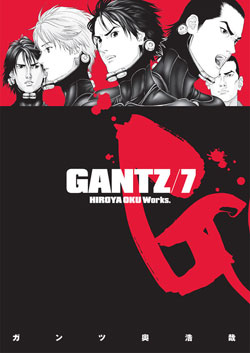
Manga Spotlight: Gantz Volume 7 By Hiroya Oku
Gantz is the Led Zeppelin of manga - thrilling, virtuositly geeky, and a bit misogynous. In volume 7, opposite the table of contents is a sort of reworked Conan tableau, with the manga's teen hero standing on the top of a mound of fallen comrades, a weapon in each hand, bellowing rage into the onlooker. Had that image been the cover, it would have been a truth in advertising statement for what the volume presents. Hot on the heels of the previous outing, here's 200 pages of desperate and/or bloodthirsty recently deceased people, granted super strength via shiny black suits and obscene offensive power via sci-fi weaponry, engaged in a death match with a host of divinely angry Buddhist statues. I'm less and less confident that Oku is taking Gantz anywhere insightful. Where the manga once seemed aimed to eviscerate adolescent fantasies, it now appears to be parading around in a wild rompus, wearing the skins of those juvenile notions. Still, this morally unencumbered culmination of the earlier exchanges in brutality, rendered in an accentuation prone, 3d modeled, digitally inked process, is quite the spectacle. Gantz is not subtle in working in a video game metaphor for its action. People, such as disaffected teenager Kei Kurono are plucked from their moment of death, and reconstituted in a barren apartment, where a black sphere gives them super-powered equipment, instructs them to kill various species of aliens, teleports them to the urban locale where the fighting is done, then teleports them back to the room to award points for success. If these undead die again in their alien extermination sortie, they're perma-dead. If they survive, but are wounded, their bodies are fixed in the transport back. Unlike previous missions where Kurono and two of his peers were saddled with creeps and liabilities, these time, their fellow non-deceased can contribute to the battle; there's a Laura Croft doppelganger with Muay Thai experience, a guy who's either military or more likely someone who died playing military otaku, a sniper and a number of species of martial artists, including a burly karateka in his gi (how all these young, healthy people might have died on this night is a bit of a conceit), a presumably MMA grappler dressed like he's been out pimpin' and a wild haired kicker (I can't identify the particular niche of this last one). In contrast to prior combatants, this crowd is not quite guilty of the capital crime of stupidity. Nor are they entirely reprehensible people. But, their temperament are well suited for the conflict for reasons beyond their martial prowess. There's sadism and exaltation of power... as when the military guy blows the legs off one of the attacking statues, taunts it, and asks it to beg. Other fighters embrace their gladiatorial role... the karate guy punches a statue... the stone deity catches the blow and snaps its attackers arm.. the dude in the gi shouts a battle cry, tackles the statue and mounts to to prep for further attach. Karate guy has a limb that is hanging by the skin, he's on top of something that can pulverize the human body into paste, but the two other martial arts still shout "that was awesome!" Gantz shares the misanthropic view of its teen protagonist. While it's eased up on knocking his self assessment down, it has not ceased to offer object lessons in how flaws in human nature can be survival liabilities. This feeds into the nastiness of the manga. Rather than gaffs made by horror victims as a conceit to rack up the monster's body count, in Gantz, people die in graphically brutal fashion because our species propensities toward thoughtlessness, self overestimation, self delusion and distraction. The recent development in Gantz is that its protagonists can give as good as they get and unleash their own, drilling through the head of the cyclopean Buddhist statue or sniping out the torso of a more person sized divinity. However, this is staged more as another outlet for disquieting behavior than it has been for catharsis or triumphant redemption. Though he has yet to be triumphant or redeemed, Kei Kurono has proved able in battle, and more intelligent and composed than most. And, he's gotten the girl, with Laura Croft falling hard for him, apparently by virtue of him being the star of the manga. There are some interesting ideas evoked that aren't fully fleshed out due to the structure of the manga and its churn from one violent chapter to the next. Kurono is taken with the notion of being heroic and likes the idea of being with his peer, but he jumps on the chance to get intimate with Croft san because he's a horny teen and she's inexplicably interested in him. The groundwork for exceptional teensploitation is here, with an interesting dynamic between Kurono, with his propensity towards giving in to weaknesses and frustrations and his peers, who are laboring to manage the best they can, and with an interesting disparity between what Kurono he wants for himself/thinks of himself, and what he does. Yet, not only does Oku lack the time to develop this, he muddies it. Not only does Gantz not have well realized female characters, they all seem to act strictly in service of the series. Love blooms on the battlefield movie personality doppelgangers like Sadako and Croft serving Oku's assigned function of hanging on Kurono. It's like one of the old Warner Bros. cartoons with Bugs Bunny mingling with the stars meets Battle Royale. As a sucker for grossly violent manga, I've had to accept that gray matter as I'd hoped for in this red meat manga. It's sufficiently hooked me that I'm looking forward to seeing what grotesque surprised volume eight has in store.

